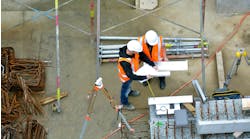We are taking our never-ending story about the future of building automation to Atlanta for the 2019 AHRExpo.com in January. Last January we were talking about transforming our industry with IoT at AHRExpo. It seemed as though everywhere you looked during the 2018 AHR Expo you were able to see the transformation of products and services; our complete industry intertwined thanks to the Internet of Things (IoT).
We are now planning our education sessions for the 2019 Expo. If you have been reading this story, then you have become a part of what we are going to talk about. The 2019 Show will be held in Atlanta, host more than 2,100 exhibitors with crowds of more than 60,000 industry professionals from every state in America and 165 countries worldwide. AHR provides a unique forum for the entire mechanical contracting industry to come together and share new products, technologies, and ideas.
I have been on the leading/bleeding edge of the building automation industry for over 35 years. I have seen pneumatic control give way to electronic, electronics turn into mainframe computers as big as refrigerators, mainframes give way to minicomputers the size of suitcases, minicomputers evolve to stand alone panels the size of clipboards which gave away to micro panels the size of pocket calculators, and now addressable input and output devices. Now that the hardware has virtually disappeared and the migration of DDC control to the Internet has begun, it seems the perfect time to get on with my life's vocation: catching up.
Digital Dinosaur Does Dallas could have been a title for a low-grade horror movie but proved to be a significant growing point for us. Our involvement in The State of the Art Building Automation session at the AHR Expo in Dallas back in 2000 helped us both inform and be informed about the rapid growth of the world wide web as well as the exciting area of evolving communication standards. We discovered that our greatest asset was the fact that we dropped out of the sky without the normal connection to large manufacturers or publishers. Once we convinced the industry that our intentions were honorable and that we wanted to build an automated building web resource the support we received was phenomenal.
(Here’s a link for those of you who care to read more about about the early years.)
Maybe that’s more information than you wanted to hear! But here now is a sneak preview of our 20th-year sessions submitted for AHR Expo 2019. You will recognize some of the evolutionary mash-ups you have been reading about in our columns.
1st Session, The Future of Building Automation Creating our new persona "Building Emotion."
Session Description — Learning Emotion by Looking, Listening, Feeling, Thinking before returning a mindful reaction in a Humanistic User Experience "HUX."
"Emotion" is the noun used to describe the creation and depiction of a mindful interactive relationship — the conversation if you will — between the inhabitants and their physical building. It is a virtual identity, a feeling, a learning, an interactive piece, a digital twin of the brick-and-mortar that hosts the buildings' emotion. "Building" is the verb or noun that modifies it. A mash-up of a fixed physical asset and its emotional contents creates the new Building Emotion identity.
So how do we best "Look" with rapidly evolving video analytics, "Listen" with natural language interaction and learning, using the personal assistants that are evolving as part of our edge-bots? Use our history of "Feeling" temperature, humidity, occupancies, etc. and best combine this all with 'Thinking" that will come from self-learning. Once complete we need to work harder on returning that mindful reaction in the creation of an Anticipatory Humanistic Relationships.
”Deviceless” mentality is an idea, that users — meaning humans — won’t have to use devices, apps or interfaces to access smart services. The method of access was suggested as anything from a mobile phone's presence to facial recognition. The underlying idea being that the creation of intelligence is hidden away in the engine room, always there and always on, but never visible to the user. This idea seems to arise from a widespread frustration at the countless apps and interfaces we need to create our present human interfaces.
The building blocks of digital transformation are: mindset, people, process, and tools. Note that tools (which equal technology) is the last item. We as an industry tend to focus on this first then try to trowel over mindset, people, process. This is not working.
Learn how to think more like software developers creating an Awesome User Experiences for the inhabitants of our buildings. We need to understand better how to be agile and sensitive to Humanistic Digital Inclusion on our new road to people-centric buildings. Humanistic Digital Inclusion is the new road that winds through our old building-centric thoughts while taking us to the new world of people-centric buildings. How might we best achieve the necessary emotional intelligence for our implementations? We need to grasp the feelings of the people by engineering empathy into our buildings and somehow incorporate those feelings into our evolving digital twin models.
We will build on last years' session Data at the Open Intelligent Edge with Autonomous Actions discussions and the discuss the transformations we all must make.
Join Scott, Brad and myself on the journey to looking over the Edge to a new world using Building Edge-Bots That Will Learn Emotion
2nd Session, Smart Environments for Humans
Session Description — To succeed at digital transformation, instead of making humans more technical, we need to make technology more human.
Welcome to Digital Mindfulness Unlocking value and opportunities from digital experiences
– Current smart environments operate on a machine level and do not understand people
– New paradigm: smart environments that can operate at a human level
– New technological innovations (AI, Emotive Computing) and advances in scientific disciplines (neuroscience, psychology) will demonstrate this to be possible
3rd Session, Smart Building Automation Evolution from Ethernet to Emotion
Session Description — Our BAS evolution is closely coupled with the internet.
What has changed in the 20 years of the Internet? Cost is down; speed is up, everything has an IP address, the Internet has become clouded with powerful microcomputers that are out on the edge, self-learning and sharing their intelligence with everyone – everyone is continuously connected.
This is AutomatedBuildings.com 20th year of providing education sessions at AHRExpo, and during that period a lot of evolution has occurred. Our session will pull from this evolution timeline the significant events and milestones that are likely to be part of our next 20 years.
We will share takeaways from the Helsinki Head Shake event and our recent 20-year industry journeys, all digitally documented. We will discuss the crest of change now coming with digital mindfulness, building emotions, and self-learning edge-bots.
Instead of trying to make humans more technically savvy, why not try to make technology more human? Come and join us for a fun industry discussion providing insight and generating new conversation.
4th Session, Exploring our Human Connection, Our Seventh Annual Connection Community Collaboratory
Session Description — How do we best "Look" with rapidly evolving video analytics, "Listen" with natural language interaction? Use our history of "Feeling" temperature, humidity, occupancies, etc. and best combine this all with 'Thinking" that will come from self-learning?
We will build on last year's Sixth Annual Connection Community Collaboratory — A Panel of Industry Thought Leaders Deliver a Successful Session Moderator Ken Sinclair, Automated Buildings, was joined by a panel of veteran industry experts: Marc Petock, Trevor Palmer, Troy Davis, George Thomas, and John Petze at the Sixth Annual Connection Community Collaboratory held at the AHR 2018 in Chicago.
The session was very well-attended by a mixed audience of manufacturers, building owners, engineers, system integrators, and HVAC contractors — and began with each panel member giving an overview of their perspectives on a range of current industry topics such as IoT, Edge Devices, Edge Processing, and the impact of IoT micro-controllers — advancing into several highly interactive discussions. Ken Sinclair summed up the success of the collaboratory best: “In the past, our sessions have primarily focused on software, analytics, and protocols. For the first time ever, hardware started to enter into the conversation with the likes of Raspberry Pi’s, Beagle boards, Amazon Echos, and Hey Google’s; a very interesting transition, which led to some extremely interesting discussions.”
Video of last year's session.
5th Session, The Future of the “Super” Master Systems Integrator
Session Description — This panel session will provide an interactive analysis of the attributes of successful Master Systems Integrators (MSI), the challenges they face and how to overcome those challenges to develop into a “Super” MSI. Staffing is proving to be a growing issue within the industry, and the panelists will explore how to find the right people, how to bring them into this industry properly, and how to continue to develop them to build the foundation for the greatest chance of success. The discussion will take a step further and dive into the business of MSI. Panelists will show examples of different types of MSI contracts/projects and break down the MSI cost and profitably against the original proposal to demonstrate what types have proved profitable and which have not. By staying at the forefront of staffing and optimal business objectives, companies have the opportunity to develop Super MSI’s that set themselves apart and create huge value on projects within standard budgets.
At the time of writing this column, we have also submitted two entry-level sessions An Introduction to Building Automation Systems BAS and Building Automation 101 and are working with Project-Haystack.org to provide an education session
We have been busy planning for this event.
In this ControlTalk Video Cast I talk more about Automated Buildings’ July 2018 Issue, “Building Emotion.” It is time for us to create an emotional sense of our building space. Siemens CEO, Matthias Rebellius agrees — because we spend up to 90% of our lives in buildings. We know that art and architecture trigger our emotions, but will buildings ever evoke their own emotions? I believe that there is a need for an improved relationship between the physical, the virtual and the emotional world.
In the hard reality of our industry and the real world of contractors, these humanistic processes have been sidelined, and that need to chang. Change is coming but it is hard and slow.



